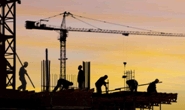Steel Markets

AGC, Procore Studies Show Impact of COVID-19 on Construction
Written by Sandy Williams
May 9, 2020
A new survey of construction firms by the Associated General Contractors of America shows that two-thirds of firms have reported project cancellations or delays due to concerns about the pandemic or future funding. Fewer construction projects equal more job losses; 43 percent of firms surveyed reported staff cuts between March and May.
Construction employment fell by 975,000 jobs in April, nearly 13 percent of the industry’s employment, according to the latest analysis of government data by AGC. April was, by far, the worst one-month decline on record, said AGC Chief Economist Ken Simonson. He added that unemployment among workers with recent construction experience soared by 1.1 million from a year earlier, to 1,531,000, while the unemployment rate in construction jumped from 4.7 percent in April 2019 to 16.6 percent.
Job reductions were most severe in the Northeast where 53 percent of firms terminated or furloughed employees, followed by the West at 45 percent and the Midwest at 38 percent. The areas hit hardest also had tougher restrictions on economic activity due to the virus. The South, where restrictions were less stringent, reported the fewest staff reductions at 29 percent.
A study by Procore, a project management company, looked at how COVID-19 impacted work hours as shelter-in-place orders were imposed. On March 1, Procore data showed 14 million logged hours. By April 26, hours logged dropped 13 percent and are now holding relatively steady. Small companies fared the worst, dropping 19 percent over the data period. Hours at large companies fell 13 percent and medium companies 12 percent. Company size was based on annual construction volume: small, less than $20 million; medium, $20-200 million; and large, greater than $200 million.
There was an overall downturn for construction markets with some more resilient than others, said Kris Lengieza, senior director of business development at Procore. Declines in hours logged for Infrastructure and non-infrastructure projects were similar. Digging deeper into project type, there was less impact on healthcare projects, while energy-related projects saw a large decline in hours in late April. Transportation hours were down more than most infrastructure sectors. Projects in bigger metropolitan areas were impacted more than those in rural areas.
“Today’s jobs report, our new survey results and Procore’s data make it clear that the construction industry is not immune to the economic damage being inflicted on our country by the pandemic,” said Simonson. “Without new federal help, it is hard to see a scenario where the construction industry will be able to recover any time soon.”
Employment losses would be even more severe if not for funding from the Paycheck Protection Program (PPP). Eighty percent of firms surveyed applied for PPP and most were approved and received funding. Confusion about eligibility, however, has led some firms to return funds fearing prosecution if they have inadvertently filed for or used funds incorrectly.
The construction industry is taking protection of its workers very seriously, said both Simonson and Lengieza. The industry has a long history of following and enforcing changing requirements. Safety protocols during the pandemic range from wearing masks and social distancing, to staggering work and break hours, to limiting the number of employees in carpools and elevators. The CDC has said that the construction industry is a model to emulate as America rebuilds the economy.
Respondents to the AGC survey indicated a number of measures they would like to see government undertake to help the industry and the economy:
- Clarification of the Paycheck Projection Program requirements
- Safe-harbor protocols to protect companies from liability if infections occur despite safety measures.
- Stronger investment in infrastructure
- Enact a COVID business and continuity fund
- Fill the $50 million funding gap for state highways
“Federal officials can, and should, take additional steps to help avoid more layoffs and economic hardship,” Simonson added. “The construction industry’s job losses have little to do with temporary work-stoppages, but a lot to do with longer-term economic problems that will not end with the stay-at-home orders.”
For more information: AGC Survey Results & Video Summary, Procore data.

Sandy Williams
Read more from Sandy WilliamsLatest in Steel Markets

USW cheers Evraz NA agreement with Atlas Holdings
The United Steelworkers (USW) labor union celebrated recent news of the signed agreement between Atlas Holdings and Evraz NA in which the Connecticut-based private equity company said it plans to acquire North America’s Evraz facilities.

Steel buyer spirits tempered by soft spot market conditions
Steel sheet buyers report feeling bogged down by the ongoing stresses of stagnant demand, news fatigue, tariff negotiations or implementation timelines, and persistent macroeconomic uncertainty.

Hot-rolled coil buyers continue seeking certainty
Steel market participants contend that buyers will remain in “wait-and-see" mode until some market stability is restored.

Latin American steel advocates warn on cheap import flood
Subsidized Chinese steel imports and cheap steel products from Association of Southeast Asian Nations (ASEAN) entering Latin American (LATAM) are threatening the region's steel market.

CRU: Steel prices fall amid global demand weakness
The forceful headwinds bearing down on steel markets across the globe have created demand challenges and sent prices southward. The US, however, challenged the global trend.
